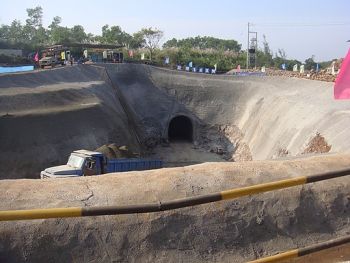Care and Diversion of Water: Difference between revisions
Rmanwaring (talk | contribs) No edit summary |
No edit summary |
||
| Line 19: | Line 19: | ||
#Size and frequency of diversion flood; | #Size and frequency of diversion flood; | ||
#Methods of diversion; | #Methods of diversion; | ||
#Specifications requirements."<ref name="Small Dams"/> | #[[Specifications]] requirements."<ref name="Small Dams"/> | ||
</br> | </br> | ||
"The method, or scheme, of diverting floods during construction depends on the magnitude of the flood to be diverted; the physical characteristics of the site; the type of dam to be | "The method, or scheme, of diverting floods during construction depends on the magnitude of the flood to be diverted; the physical characteristics of the site; the type of dam to be constructed; the nature of the appurtenant works, such as the spillway, [[penstocks]], or outlet works; and the probable sequence of construction operations. The objective is to select the optimum scheme considering practicability, cost, and the risks involved. The diversion works should be capable of being incorporated into the overall construction program with minimal impact and delay."<ref name="Small Dams"/> | ||
constructed; the nature of the appurtenant works, such as the spillway, [[penstocks]], or outlet works; and the probable sequence of construction operations. The objective is to select the optimum scheme considering practicability, cost, and the risks involved. The diversion works should be capable of being incorporated into the overall construction program with minimal impact and delay."<ref name="Small Dams"/> | |||
If a cofferdam is proposed, its hazard potential to the downstream public should be evaluated. Design criteria should be imposed by the regulating agency commensurate with that risk. The regulating agency may consider the anticipated service life of the structure and other risk reduction measures when determining appropriate design criteria for the structure. The dam [[owner]]'s construction insurance policy may also specify design criteria for temporary conditions during construction. | |||
==Best Practices Resources== | ==Best Practices Resources== | ||
Revision as of 21:16, 17 March 2023

|
| Construction of a tunnel for the diversion of water at a construction site. |
"The design for a dam that is to be constructed across a stream channel must consider diversion of the streamflow around or through the damsite during the construction period. The extent of the diversion problem varies with the size and flood potential of the stream; at some damsites diversion may be costly and time-consuming and may affect the scheduling of construction activities; whereas, at other sites it may not present any great difficulties. Nevertheless, a diversion problem exists to some extent at all sites except those located offstream, and the selection of the most appropriate scheme for diversion during construction is important to the economy of the dam."[1]
"The diversion scheme selected ordinarily represents a compromise between the cost of the diversion facilities and the amount of risk involved. The proper diversion scheme will minimize the potential for serious flood damage to the work in progress at a minimum of expense. The following factors should be considered in a study to determine the best diversion scheme:
- Streamflow characteristics;
- Size and frequency of diversion flood;
- Methods of diversion;
- Specifications requirements."[1]
"The method, or scheme, of diverting floods during construction depends on the magnitude of the flood to be diverted; the physical characteristics of the site; the type of dam to be constructed; the nature of the appurtenant works, such as the spillway, penstocks, or outlet works; and the probable sequence of construction operations. The objective is to select the optimum scheme considering practicability, cost, and the risks involved. The diversion works should be capable of being incorporated into the overall construction program with minimal impact and delay."[1]
If a cofferdam is proposed, its hazard potential to the downstream public should be evaluated. Design criteria should be imposed by the regulating agency commensurate with that risk. The regulating agency may consider the anticipated service life of the structure and other risk reduction measures when determining appropriate design criteria for the structure. The dam owner's construction insurance policy may also specify design criteria for temporary conditions during construction.
Best Practices Resources
![]() Design of Small Dams, USBR, 1987
Design of Small Dams, USBR, 1987
Trainings
![]() On-Demand Webinar: Stream Management for Dam Construction
On-Demand Webinar: Stream Management for Dam Construction
![]() On-Demand Webinar: Managing Increased Dam Safety Risk During Reconstruction
On-Demand Webinar: Managing Increased Dam Safety Risk During Reconstruction
Citations:
Revision ID: 6720
Revision Date: 03/17/2023
